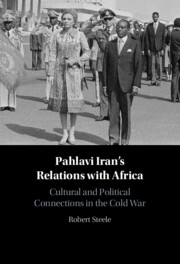Book contents
- Pahlavi Iran’s Relations with Africa
- Pahlavi Iran’s Relations with Africa
- Copyright page
- Contents
- Figures
- Acknowledgements
- Note on Transliteration
- Introduction
- Part I Establishing Relations (c. 1957–1970)
- 1 Iran, Egypt and the Spectre of Nasserism
- 2 Iran, North Africa and Islamic Solidarity
- 3 ‘Creating Influence and Dialogue with the African Continent’ (1960–1968)
- 4 Establishing Ties with Apartheid South Africa
- Part II Forming an Africa Policy (1971–1975)
- Part III Africa and Pahlavi Iran’s Grand Strategy (1976–1979)
- Conclusion
- References
- Index
2 - Iran, North Africa and Islamic Solidarity
from Part I - Establishing Relations (c. 1957–1970)
Published online by Cambridge University Press: aN Invalid Date NaN
- Pahlavi Iran’s Relations with Africa
- Pahlavi Iran’s Relations with Africa
- Copyright page
- Contents
- Figures
- Acknowledgements
- Note on Transliteration
- Introduction
- Part I Establishing Relations (c. 1957–1970)
- 1 Iran, Egypt and the Spectre of Nasserism
- 2 Iran, North Africa and Islamic Solidarity
- 3 ‘Creating Influence and Dialogue with the African Continent’ (1960–1968)
- 4 Establishing Ties with Apartheid South Africa
- Part II Forming an Africa Policy (1971–1975)
- Part III Africa and Pahlavi Iran’s Grand Strategy (1976–1979)
- Conclusion
- References
- Index
Summary
The threat of Nasserism shaped the shah’s regional strategy in the 1950s and 1960s. This chapter explores the development of the shah’s policy of building relations with moderate allies in the Arab world who could help to contain and balance the radicalism of Nasser. The shah found two allies in North Africa: Tunisia under President Habib Bourguiba and Morocco under King Hassan II. Bourguiba and King Hassan were, like the shah, moderate rulers, with strong ties to the West, who shared the same concerns over Egyptian ambitions and the threat that Nasserism posed to regional stability. One of the strategies the shah developed, for which he sought the support of King Hassan in particular, was to challenge Nasser’s claims to leadership in the Islamic world, by attempting to form a separate grouping of Islamic countries. The ultimate manifestation of this was the Islamic Summit Conference, held in Rabat in 1969, in which King Hassan and the shah played leading roles.
- Type
- Chapter
- Information
- Pahlavi Iran's Relations with AfricaCultural and Political Connections in the Cold War, pp. 41 - 64Publisher: Cambridge University PressPrint publication year: 2024



